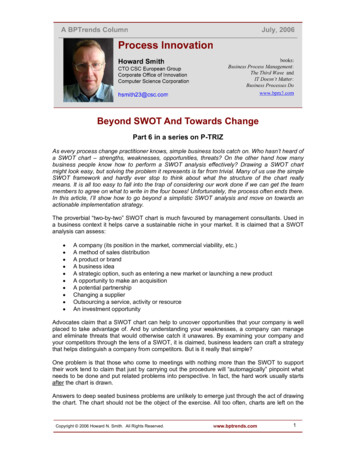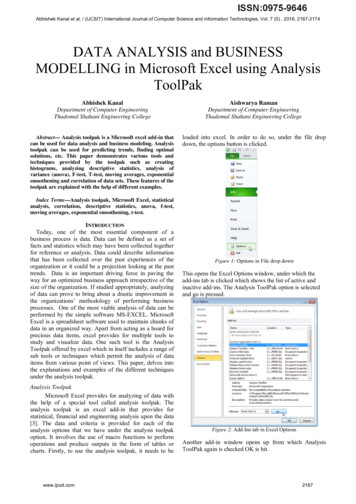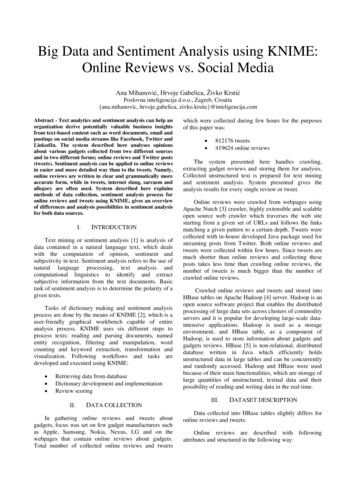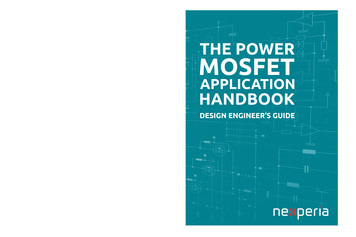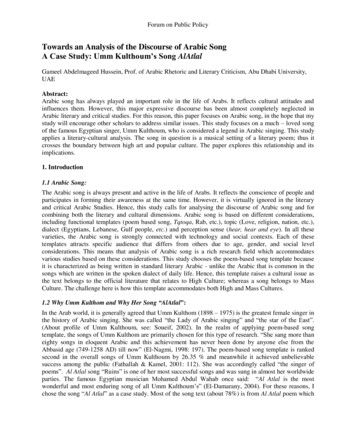
Transcription
Forum on Public PolicyTowards an Analysis of the Discourse of Arabic SongA Case Study: Umm Kulthoum’s Song AlAtlalGameel Abdelmageed Hussein, Prof. of Arabic Rhetoric and Literary Criticism, Abu Dhabi University,UAEAbstract:Arabic song has always played an important role in the life of Arabs. It reflects cultural attitudes andinfluences them. However, this major expressive discourse has been almost completely neglected inArabic literary and critical studies. For this reason, this paper focuses on Arabic song, in the hope that mystudy will encourage other scholars to address similar issues. This study focuses on a much – loved songof the famous Egyptian singer, Umm Kulthoum, who is considered a legend in Arabic singing. This studyapplies a literary-cultural analysis. The song in question is a musical setting of a literary poem; thus itcrosses the boundary between high art and popular culture. The paper explores this relationship and itsimplications.1. Introduction1.1 Arabic Song:The Arabic song is always present and active in the life of Arabs. It reflects the conscience of people andparticipates in forming their awareness at the same time. However, it is virtually ignored in the literaryand critical Arabic Studies. Hence, this study calls for analysing the discourse of Arabic song and forcombining both the literary and cultural dimensions. Arabic song is based on different considerations,including functional templates (poem based song, Tqtoqa, Rab, etc.), topic (Love, religion, nation, etc.),dialect (Egyptians, Lebanese, Gulf people, etc.) and perception sense (hear, hear and eye). In all thesevarieties, the Arabic song is strongly connected with technology and social contexts. Each of thesetemplates attracts specific audience that differs from others due to age, gender, and social levelconsiderations. This means that analysis of Arabic song is a rich research field which accommodatesvarious studies based on these considerations. This study chooses the poem-based song template becauseit is characterized as being written in standard literary Arabic - unlike the Arabic that is common in thesongs which are written in the spoken dialect of daily life. Hence, this template raises a cultural issue asthe text belongs to the official literature that relates to High Culture; whereas a song belongs to MassCulture. The challenge here is how this template accommodates both High and Mass Cultures.1.2 Why Umm Kulthom and Why Her Song “AlAtlal”:In the Arab world, it is generally agreed that Umm Kulthom (1898 – 1975) is the greatest female singer inthe history of Arabic singing. She was called “the Lady of Arabic singing” and “the star of the East”.(About profile of Umm Kulthoum, see: Soueif, 2002). In the realm of applying poem-based songtemplate, the songs of Umm Kulthom are primarily chosen for this type of research. “She sang more thaneighty songs in eloquent Arabic and this achievement has never been done by anyone else from theAbbasid age (749-1258 AD) till now” (El-Nagmi, 1998: 197). The poem-based song template is rankedsecond in the overall songs of Umm Kulthoum by 26.35 % and meanwhile it achieved unbelievablesuccess among the public (Fathallah & Kamel, 2001: 112). She was accordingly called “the singer ofpoems”. Al Atlal song “Ruins” is one of her most successful songs and was sung in almost her worldwideparties. The famous Egyptian musician Mohamed Abdul Wahab once said: “Al Atlal is the mostwonderful and most enduring song of all Umm Kulthoum’s” (El-Damarany, 2004). For these reasons, Ichose the song “Al Atlal” as a case study. Most of the song text (about 78%) is from Al Atlal poem which
Forum on Public Policywas composed by the Egyptian poet Ibrahim Nagy (1899 – 1953) and was published in 1952. Theremaining song text (about 22%) was taken from another poem by the same poet entitled “Al Wadaa”(Farewell) and published in 1934. The two poems were published in the poetic collections of the poet(Nagy, 1988: 34). The music was composed by the Egyptian musician Riyad Al Sonbati and first sung byUmm Kulthoum in 1966.2. Literature ReviewThe relevant research shows that there is no one cultural literary analytical study of Umm Kulthoumsongs or other Arab songs. However, there have been many studies that dealt with the life of UmmKulthoum, her songs, and her role in boosting the cultural and artistic life and its relationship with societyand politics. (Fathallah and Kamel, 2001; El-Mahallawy, 1999; 1992; 2001; El- Naqash, 2000, Fouad,2000; Danielson, 2000, and Middletown, 2010).2.1 The Theoretical Framework2.1.1 High Culture and Mass CultureThe terms of High Culture and Mass Culture have many definitions the same as the term “Culture” itselfhas. (About the concept of Culture, see Williams, 1986). High Culture covers “two features of the culturalattributes. First, it is created by cultural elite or under their supervision and care. Such elite is working in aheritage, literary, or scientific framework. Second, it applies the critical accurate standards that areindependent of the tradition of this cultural element” (El-Gohary and Others, 1999:54). For Mass Culture,“there are some scholars who define it as both cultural and material published by means of masscommunication. Others consider it as entertainment materials or leisure at the level of popularity (ibid:52). There cases are too difficult to separate between the two cultures. It is because the high culture canturn into a mass culture and vice versa. Arthur (2003: 193) says, “it will be difficult in some cases to saywhen and where the popular arts stop, or to say that there is an art for the elite or the high-leveled peopleor vice versa. If Shakespeare’s play “Hamlet” is televised, could we say then that it has become a massculture?” I do not think that the mere transmission of high culture through the means of masscommunication (TV, radio, tape, journalism . etc.) can convert it to a mass culture. It can be only if weuse the description “Mass” synonymous with the term Media. But if it is used synonymous with“popular”, which means that “it is a strongly loved type to the majority of people” as suggested byRaymond Williams (Easthope, 1996: 76), there is an essential condition for this transformation which isrelevant to people’s acceptance to what they receive. In this case, it will be what is known as “descendingcultural heritage”. According to sociologists, this term means that “cultural materials were developed bythe high class in community, then moved and adopted by the public” (Eike, 1986 the term of CulturalHeritage downward).Danielson considered the voice of Umm Kulthoum as a “collective voice that expresses a patternof values” (Danielson, .2000:291). Has the description of “collective” been achieved in the song of AlAtlal?” And what are the patterns of values expressed in the song? values are included in “CovertCulture” which is, according to sociologists, “the knowledge, attitudes and values that are shared bymembers of the community that are perceived only through deduction from uncovered culture, which isbased on covert culture. Kluckhohn argues that the covert culture includes the unconscious elements andfeatures hidden in culture” (Eike, 1986: Covert Culture term). Some of those values represent the corefeature that distinguishes character of the community, which is known as “Genius of Culture”. It means,according to Sapir definition, “general trends, the view of life and special features of civilization, whichprovide their owner specific position in the world” (ibid: Genius of Culture term). The study questionhere, has the song Al Atlal expressed the essence of Islamic Arab culture?
Forum on Public Policy2.1.2 The Philosophy of Music and Its Psychological ImpactMusic is considered as one of the most connected arts to the human emotions on both production andreceptiveness levels. The inner world is a world of feeling and emotions. In this world "the music looksfor its counterparts, then it expands to become an expression of all private feelings and emotions, anexpression of all forms of fun, joy, joke, whim, and the elevation of spirit and its rewards, as well as alldegrees of anxiety, dengue, sadness and complaint. I would call all of these feelings as the “groans ofself” (Hegel, 1980: 25). Music achieves its function via technical treatment that establishes relationsbetween sounds on a quantitative basis and numerical ratios that are not used in music . unless afterbeing discovered by art and diversifies the nuances among them to a great extent. From this perspective, alive organic unity does not make the base of compose music, but equality and diversity that make this”."(ibid, 38). Hegel claims that “the lengthening sounds produced by instruments such as stringed and brassinstruments provide the substantial characteristic for melody; whereas other instruments like drum,tambourine, and harmonica only have a secondary role. As if there is a connection between internalfeelings and lengthening sounds which make internal feelings in need to lengthening sounds to expressitself”. (ibid, 51). Hegel also applied what he mentioned about the characteristics of musical instrumentson human sound as it combines both stringed and pumped instruments (ibid, 51). Hegel also clarified thatthe musical expression travels from the inner sense of sender to the inner sense of receiver who respondsto tunes simultaneously and unconsciously (ibid, 29-30). This explains how some audience could respondto songs although they don’t understand some of its words and expressions, as music and singing conveyfeelings via sense, not meanings mediated by mind and logic.Some psychologists reveal characteristics of music and how it has a significant physiological andpsychological influence of human soul. “It has been found that loud and fast music increases heart rates,and creates a sense of excitement. Frequently-repeated rhythm can lead to some form of unconsciousnessor faintness that sometimes reaches up to the point of ecstasy and comprehensive indulgence. This hasbeen attributed to the neural circuits that repeat or rewind the echoes of voices in a way that can causechanges in brain chemistry, or something like electrical shocks similar to epileptic convulsions. Thesechanges in turn edit or release an extraordinary behavior not necessarily conforming to religious rituals,sexual stimuli, and bizarre dances” (Wilson, 2000: 285). Glenn Wilson also presents one of the ways inwhich music attracts feeling. It is called “Association” and has three modes including: Cross-ModalAssociation (Analogies). It is related to metaphorical representation, which usually has a spatial or visualform. An appropriate example of this is the bilateral love which loops up to the sky and the nationalanthem that is an indication of persistence and determination that stirs motivation. The musical clip, onthe other hand, is often slow and laborious and full of gloomy colors the same as youth, light and warmmusic . There are some obvious musical analogies with external things like high rhythm in contrast oflow tones (ibid: 289: 291).3. Method (A Literary Cultural Approach)Many disciplines like textual linguistics, discourse analysis and cultural analysis tend to analyze the textsand discourses of different kinds, though the terminology, concepts, procedures, and concerns vary fromone perspective to another. If pure textual trend focuses on the text and its language structure, DiscourseAnalysis goes beyond these limitations to the factors of production and mechanisms of receiving andconceiving them. These factors and mechanisms are covered by the terms “Context” and “Pragmatics”.Hence, the concept of “Discourse” is much broader and deeper than the concept of “Text”. It also coversboth the linguistic and non-linguistic signs. So the study prefers to use it. In addition, going beyond thetext to what are behind it is the main concern of Cultural Studies since they focus on cultural patterns andcodes, mental patterns, unconscious dimensions, and ideological conscience, etc. Moreover, they givespecial attention to popular discourse such as movies, serials, songs, advertisements, children's literature,
Forum on Public Policypopular literature (Leach, 2000 and El- Ghazzami, 2001). However, addressing the cultural dimensionsonly makes the analysis a pure cultural one that ignores the issue of literary criticism (Poetic). In aprevious study, the researcher found it is important to keep (Poetic) as a core issue for literary criticismand meanwhile enriches it with cultural criticism. So I called to make a vision of how literary criticismcan benefit from cultural criticism so that the analysis covers both literary and cultural criticism. Thisstudy repeats this calling, so it takes an approach that combines both the literary and cultural dimensionsforming what can be seen as a literary-cultural analysis. Accordingly, the questions of this study are:1.2.3.4.5.6.What are the deviations of the song from the original poem? What is their value?What segments did Umm Kulthoum repeat? What is their value?What segments were more exciting to the audience and why?What is the relationship between the text and both musical and singing performances?What are the cultural patterns that the song addresses?How did the song accommodate both High and Mass cultures?4. Song’s Analysis4.1 Text Deviation in the Song of Al AtlalThere are many text deviations in the song from the original poem. These deviations came on four levels:the deletion, substitution, addition, distribution. The poem consists of 134 lines spread over 33 verses.The song selects only 25 lines that make up around 19% of the whole poem. Table 1 shows thedistribution of lines on the verses of the poem and the numbers of deleted lines. The mark (x) refers to thedeleted verses whereas the mark (-) means no deletions. It can be noted that 25 verses had been deletedentirely to limit the choice to eight verses (1, 4, 9, 10, 15, 17, 24 and 29) and only one of them, verse 29,was taken as a whole. For the rest selected verses, they were taken from each segment in which the firstthree lines were selected and the last line of the segment was left out. The first segment of the songcombines between the selected lines from both the first and fourth verses. Moreover, the song hasreplaced some other vocabulary and structures and misrepresented morphological structure for some time.The meaning sometimes changed and in other cases it was veered slightly from the obvious meaning ofan item. The song also made a sound amendment to some vocabulary either by increasing or decreasing.Table 2 figures out these replacements and modifications.
Forum on Public PolicyTable 1: Deletions in the SongNo. of thePoem verse12345678910111213141516The verselinesDeleted line No. of the The versePoem verse 1718192021222324252627282930313233Deleted 31-134Table 2: Replacement and Modification in the SongAl AtlalPoemGod bless the lovenobilityKingtastyAlmas’a (night)bloodcoquterymy bonesYadi (my both hands)Shai ( anything )Ali (on me)Ladi (my own)poetAlt’ama (recover)tell me that fate has willed itSongDo not ask where the love has goneprideangeldelicateAlmasa: (night)madlySelf-importantmy ribsYadiyya: (my both hands)Shaiyya: (anything)Aliyya:(on me)Ladiyya: (my own)sleeplessAlta:ma (recover)fate has willed it68XXXXXX98XXXXxxxx
Forum on Public PolicyUmm Kulthoum added 7 lines to the song taken from another poem authored by the same poem called(Alwadaa). These lines were inserted into the fabric of the lines of Al Atlal which required re-positioningof the selected lines from Al Atlal poem. The selected lines from verses 15 and 17 came earlier before thelines selected from verses 9 and 10. By all these forms of deletion, substitution, addition, and repositioning, the song conducted its text (Appendix 1).4.2 RepetitionThere are a lot of repetitions in the song. We can distinguish between two kinds of repetitions: fullrepetition; repeating whole segment and partial repetition; repeating a part of the segment. The followingtables show the repetition of both types:Full Repetition:Segment234No. of repetition234Partial repetition:No. of line12347891011121314A – Line LevelNo. ofNo. of No. ofrepetition242374423632B – Hemistich LevelHemistichNo. of repetitionOh my heart, don't ask where the love has goneAnd my longing for you cauterized my ribsAh, your handcuff has bloodied my wristsHe is sure-footed walking like an angelAnd from longing, there is a messenger between usHas love seen drunken people like us?!And we walked in a moonlit pathWakefulness ruined the dreams of slumberAnd life is as we know it,My darling everything is fated46664168234
Forum on Public PolicyC – Sentence LevelSentencefate has willed itNo. ofrepetition3D – Semi-sentence LevelSemi-sentenceOppressivebeautyNo. ofrepetition8E – Word LevelWordMy HeartDrunken peopleNo. ofrepetition9344.3. Music Introduction and Segment 1 (Lines 1-6)The musical introduction was played with numerous machines that assorted between stringed ones(violin, zither, and Cello), brass ones (flute), and percussion ones (tambourine) that sometimes wereplayed together, sometimes alone, and sometimes interchangeably to create a prelude music that is verywell suited for the text of the song. As the melody was slow and soft, it evoked the feeling of sadness.The musical introduction began with unstructured style (ad lib). Firstly, violins were played longitudinalsounds that signify the sense of distress and sadness. Gameel (1968) illustrated this sense as he said, “Thelistener’s feeling of the jerking of violin bow is closer to the viewer’s feeling of dark colors portrait”.The zither entered with the rest of the instruments in an eye-catching tonal dialogue which attracted theattention of the listeners and stirred their constant applaud. The melodic dialogue seem as a languishingbetween a person complaining and the group sounds sharing him his complaints and groans. Perhaps thiswas one of the reasons for the desirability of listeners for this musical dialogue. It can be said that in thistonal dialogue there exists what relieves the sad individual through the feeling of others and their sharingof his groans. The conversational tone is related to many positions in the song’s text, where interactivetext dialogue exits in the form of sad monologue “oh my heart don’t ask where love has gone” andsubmissive peaceful discourse “Oh sleepless one who slumbers”, “My darling everything is fated”, “don’tsay it was by our own will, but fate has willed it”. The interactive melodic dialogue conjures up oldmemories - as mentioned in the heritage of Arabic poetry as in the interactive dialogue between poet andtraditional monuments. The rhythm appears over seven equal sessions, so the melody of the introductionseems to be divided into seven sessions. This division probably was developed to indicate the textualdistribution as the text is also divided into seven segments as well. The introduction melody involves thelisteners and takes them to an expandable world of caves as if they were the desert caves that inspired theArab poets of pre-Islamic age. Also these caves work as the spiritual ruins that love story of the poem –Ibrahim Nagy ended with as he mentioned in his prelude of the poem, “this is a lost love story of twopeople who once met and loved each other. Then the story ends as the woman has become - ‘ruins ofbody’ and the man has become ‘ruins of spirit” (Nagy, 1988: 132). This poem represents a journey insidethese ruins, whereas the musical introduction reflects this journey and prepares for it. The rhythmic toneinvaded the monotony of unstructured style (ad lib), then the melody again come back to the unstructuredstyle (ad lib). So the melody of introduction seems fickle like the semantic of the song text that includesforgetting and remembering, submissiveness and insurgence, drunkenness and awareness, sadness andhappiness. As the variety of the introduction melody, the song and musical intervals took the same formin which they shifted between structured and unstructured rhythms. The introduction melody explicitlyprepared for the song text in meaning and singing. It gave a general sense of sadness and the text detailedit.The song deleted the fourth line from the first verse of the poem since it did not provide additionalmeaning expressed in its prior lines that the song chose them. Furthermore that, its vocabulary andstructures were ambiguous for the public people. Moreover, it was linked with the semantic of death that
Forum on Public Policywas expressed in the phrase “God bless love” which was replaced by the phrase “Do not ask where lovehas gone” removing by this the semantic of death given in the opening lines of the song (lines 1-3). Theopening part is one of the positions in which Arabic rhetoric emphasized the importance of euphuism withthem for communication considerations, as based on the opening part, listeners will (not) embark tohearing. The Arabic rhetoric also emphasized the exclusion of the expressions that indicate or refer todeath (Qazwini, 1998: 519). Excluding the implication of death, as I see, the song considers thepsychological impact of this on the Arab audience which is the aversion from the story of deathparticularly in singing atmosphere which is linked in Arabic culture with enjoyment.Umm Kulthoum divided the first hemistich of the first line by repeating the first item “Oh, My heart”twice independent of what comes after it and then repeats it in combination with the other items of thehemistich. She repeated it independently for the fourth time and repeated it along with the whole line forthe fifth time. The last two forms of performance were repeated for three consecutive times. Therepetition of “Oh, My heart” was repeated for nine times. Through this lexical item, the whole monologueis directed to inner, and its repetition evokes the inner of both the singer and audience. Hence, the singingand hearing come in the domain of inner. Substituting the phrase “God bless love” with “Do not askwhere love has gone” is an indication of substituting the deserted past and expressing mercy over it withprohibition about question that the heart is worried with it. Hence, there is a worry in the inner and thesong with its call and prevention expresses these feelings.The first hemistich of the first line “Oh, My heart, don't ask where the love has gone” has fivelengthening sounds as shown in bold letter “Ya: fow'a: di: la: tasl ayna lhawa:”.The duration of timeoccupied in each of the first four lengthening sounds lasted for 0.5 second, and this period multiplied inthe performance of the fifth one to one second. There accordingly seems to be an equality and diversity inperformance that gives the prolonged tone more extensions: 0.5 0.5 0.5 0.5 /1. This prolongedextension reaches its utmost in the first two lengthening in the second hemistich that represents the groansof lost love (It was a citadel of imagination that has collapsed). The extension of “Ka:na – reached 1.5seconds and it increased in performing of “khaya:ln – imagination” to reach 8 seconds. Through thisforms of extension, there could be a metaphorical representation which is a form of association betweenmusic and meaning. (See 2.1.2). As the extension of “Ka:na” represents an immersion in the past, theextension of “khaya:ln “ represents immersion in rising of imagination which is about to touch the sky. Atonal discrepancy also emerged in the performance of “fahawa – collapsed” whose extension only took0.5 second that reflects the short period of collapse as if it occurred in a wink of time (See appendix 2).SecondsLe ngthening sound me assure d in a:a:Legnthening sounda:a:a:
Forum on Public PolicyFigure 1: The forms of lengthening sounds with their equality, diversity, ascending and descendingThus, making the base of composed music by equality and diversity and the connection between internalfeelings and lengthening sounds as Hegel mentioned (see 2.1.2) manifested in the performance of thelengthening sounds of the first line. As the inner expressed its misery through stretching lengtheningsounds particularly when they vary from high to low representing the shocks of the inner when suddenfall after it was flying in the sky.Umm Kulthoum performed the second line in the same low and slow tone that she used to begin her song.This line had changed from the informative style “it was a citadel of imagination that has collapsed” tothe imperative style to order the heart “Pour me and drink on its ruins, etc.” In this context, it has to gulpalong with his owner the taste of sadness and sorrow. The third line moves from the imperative style tothe interrogative style to show the pains and regrets for the situation. Umm Kulthoum sound rises in theperformance of the two words “Zaka elhob - That love” particularly “Zaka- That” which make themobject of focus. It is seemed to me, that this indicate to the object of pain and regret which is that the lovehas gone and it is indicated to it by using the demonstrative article which use for indicating to far issue(Zaka- that.).The second and third verses of the poem (lines 5-12) were removed from the song since they deal with thestrength of love and incapability of being released from it. In these two verses, there were plenty offigurative and metaphorical expressions some of them encompass obscurity or lexical and connotativecomplexity, whereas some others were wrapped with frustration and depression. These verses express aspeech with the soul about its painful memories, hence both of love and lover are linked with pain, andthey are only expressed through the third-person pronoun. Indeed, all these are enough reasons to removethese two verses out of the song. Furthermore, the meaning of the strength of love is expressed fromanother perspective in the fourth and fifth verses of the poem (lines13-20). While composing the song inits final format, three lines were taken from verse four and being added to its segment one (lines 4-6).These lines are distinguished from the third and fourth verses that were removed from three features. Thefirst of them is clarity of meaning for the public audience where most of their vocabulary items arecommon. The second feature is recalling the happy memories that express fascinating exciting memoriesother than retrieving disconnection, pain, and torture. The third feature is directing speech to a presentlover by using the pronoun of second person like “Ansak – forget you”, “aghraitani – you seduced me”,and “Ainaik – your eyes”, and by expressing what both two lovers do in the present tense.As for the lines of the fifth verse that were completely deleted, they express senses of spirituality thatcould conflict with the lines quoted from the fourth verse which plunge in sensuality like “you seducedme with a sweetly-calling and tender tongue, a hand extending towards me, a shining light that a nighttraveler is thirsty for”. That sensuality was expressed in Arabic through the use of adverbs that specifywhat cannot be forgotten. The preference of the song to signal the physical sense more than the spiritualone already indicates the general taste of the audiences of their inclination to describing the perceptualfeeling and the perceptual pleasure. Perhaps observation to this sensuality represented in the other songsof Umm Kulthom like (Enta Omri – you are my ultimate life) and (elhob Kolloh – the overall love)signify these features.The fourth line of the song provided a signification of a figurative turning from a lover who abandonedand hurt his partner to a lover who was being abandoned and hurt by another partner and from absent lostlove to a continuous active one. For this, the prior musical tone was a bit long as a preparation for thisturning point, and the repetition of this verse three times was a sign of this conversion. Umm Kulthoumextended the repeated lengthening sound in the item “almona:da:ti – calling” with lowering the last sound
Forum on Public Policy(ti) to the least. Hence, the explosion of the two sounds (da and ti) is almost disappeared. It is necessary todisappear such explosion because it isn’t conforming to sweetness which the line talks about. Also theemphasis of the two sounds (r and q) in the word “raqiq – tender” disappeared, so the soundpronunciation appears soft. Using the present tense in the two descriptive verbs “tamtaddo- extendingYazmae – thirsts” in the fifth line almost make the audience forget that these actions were in the past. Theperformance of the (h) sound in the word “nahwi – towards me” and the sound of (m) in the word “min”were highly distinctive of which they were not performed in the same way in any similar part of the song.This murmur performance of the (h) sound signifies the release of the sound from a very tiny outlet thesame as the one whose mouth is full of water to the extent that he is about to get suffocated. As for thesound of (m), it was performed as if it was taken by force in a way that embodies a hand that stronglypulls out water. In addition, the extension of the lengthening sound in the word “ghari:q - a drowningperson” represents a diver who goes deep to the level that a drowning person cannot survive. The verb“yazmae – gets thirsty” with its present tense indicates that there is a longing to the darling. Byquestioning “Where in your eyes is that shining light?!” the person becomes wholly captured in that loverand the charming captor. The song added these lines to the song beginning lines forming by
and critical Arabic Studies. Hence, this study calls for analysing the discourse of Arabic song and for combining both the literary and cultural dimensions. Arabic song is based on different considerations, including functional templates (poem based song, Tqtoqa, Rab, etc.





